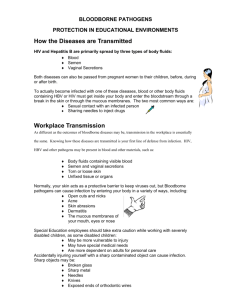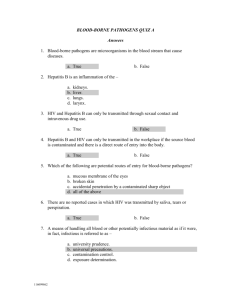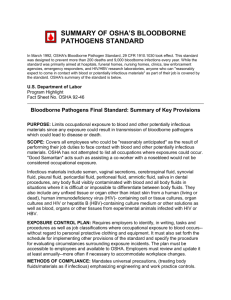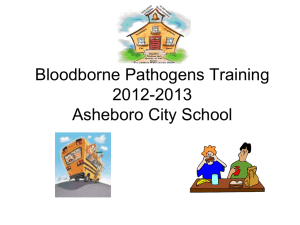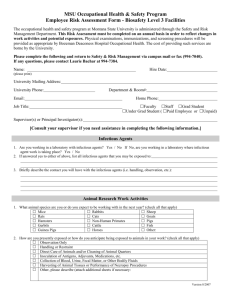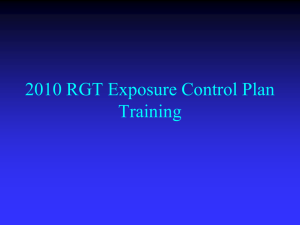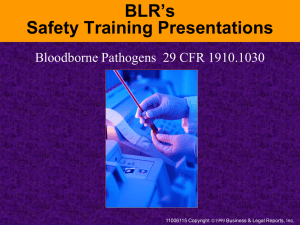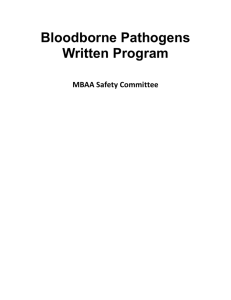Exposure Control Plan - Environmental Health & Safety
advertisement
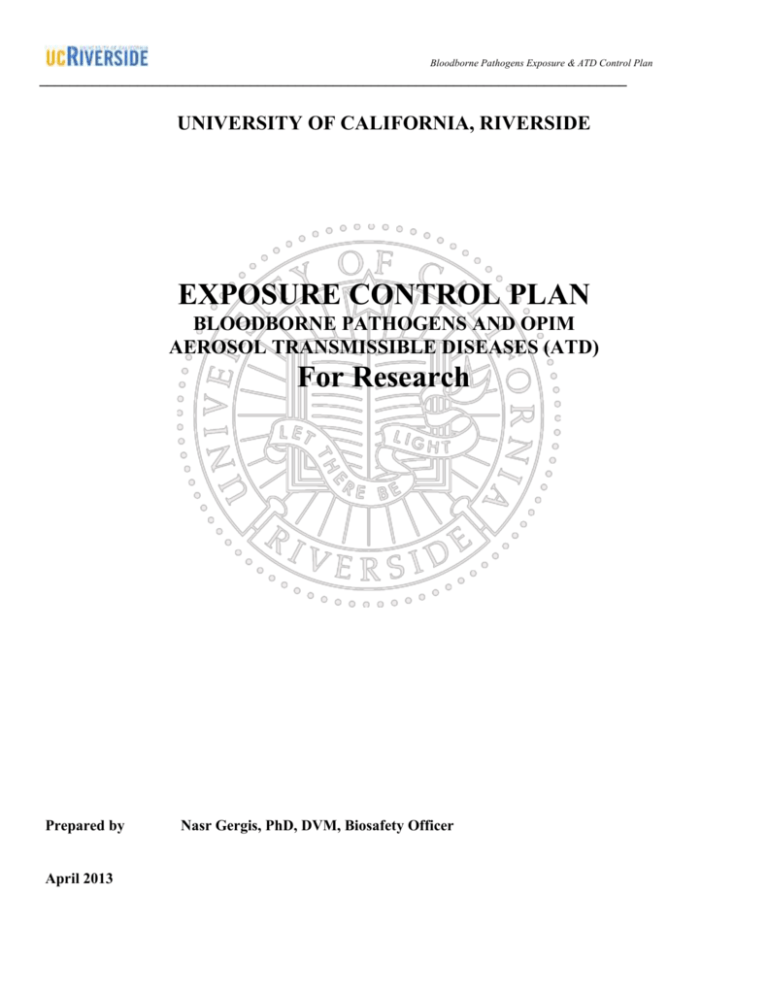
Bloodborne Pathogens Exposure & ATD Control Plan ______________________________________________________________________________ UNIVERSITY OF CALIFORNIA, RIVERSIDE EXPOSURE CONTROL PLAN BLOODBORNE PATHOGENS AND OPIM AEROSOL TRANSMISSIBLE DISEASES (ATD) For Research Prepared by April 2013 Nasr Gergis, PhD, DVM, Biosafety Officer UNVIERSITY OF CALIFORNIA, RIVRRSIDE BLOODBORNE PATHOGENS and OPIM EXPOSURE CONTROL and AEROSOL TRANSIMISSIBLE DISEASE PLAN TABLE OF CONTENTS Table of Contents SECTION I: INTRODUCTION AND SCOPE General Information and Instructions SECTION II: DEFINITIONS SECTION III: RESPONSIBILITY Principal Investigators (PI) Environmental Health and Safety (EH&S) Human Resources (HR) Departmental Chair /Director SECTION IV: OCCUPATIONAL EXPOSURE DETERMINATION SECTION V: METHODS OF COMPLIANCE 1. Engineering Controls 2. Work Practice Controls 3. Handling Specimens 4. Equipment Repair 5. Hand Washing 6. Housekeeping and Waste Disposal 7. Regulated Waste 8. Regulated Waste Handling SECTION VI: PERSONAL PROTECTIVE EQUIPMENT (PPE) 1. Laboratory Coat/Gown 2. Gloves 3. Face Shield and Eye protection SECTION VII: COMMUNICATION OF HAZARDS TO EMPLOYEES 1. 2. 3. 4. Labels and Signs Labeling Exceptions Signs Training SECTION VIII: SURVEILLANCE PROGRAM 1. 2. 3. 4. Vaccination Hepatitis B Virus (HBV) Vaccination Reporting Exposure Incident Post-Exposure Evaluation and Follow-up SECTION IX: RECORDKEEPING 1. 2. 3. 4. Training Records Medical Records Hepatitis B Immunization Records Bloodborne Pathogens Incident Log SECTION X: PLAN REVIEW AND UPDATE SECTION XI: APPENDICES Appendix A Vaccine Declination Appendix B Biohazar Symbol Appendix C Information about Hepatitis B & C Virus (HBV & HCV) Appendix D Information about Human Immunodeficiency Virus (HIV) Appendix E Exposure Control & ATD Control Template (For Research) UNVIVERSITY OF CALIFORNIA, RIVERSIDE BLOODBORNE PATHOGENS AND OPIM EXPOSURE CONTROL and AEROSOL TRANSIMISSIBLE DISEASE PLAN SECTION i: INTRODUCTION AND SCOPE General Information and Instructions OSHA and CAL/OSHA define occupational exposure as reasonably anticipated skin, eye, mucous membrane, or parenteral contact with human blood or other potentially infectious materials (OPIM) that may result from the performance of an employee’s duties. Required Standards: OSHA 29 CFR 1920.1030 http://www.osha.gov/pls/oshaweb/owadisp.show_document?p_table=standards&p_id=10051 Cal/OSHA CCR Title 8 Section 5193 http://www.dir.ca.gov/title8/5193.html Cal/OSHA CCR Title 8 Section 5199 http://www.dir.ca.gov/title8/5199.html If there are any questions regarding this form, please contact the Biosafety Officer at 951-827-2648. SECTION II: DEFINITIONS Blood: means human and some non-human primate blood, human and some non-human primate blood components, and products made from human and some non-human primate blood. Bloodborne pathogens (BBP): are pathogenic microorganisms that are present in blood and can cause disease in humans. These pathogens include, but are not limited to, hepatitis B virus (HBV Hepatitis C Virus (HCV),) and human immunodeficiency virus (HIV), and OPIM. Potentially infectious materials: all human body fluids that may be contaminated with blood and other materials, as specify in the following: o Specific human body fluids include semen, vaginal secretions, cerebrospinal fluid, synovial fluid, pleural fluid, pericardial fluid, peritoneal fluid, amniotic fluid, saliva in dental procedures, any other body fluid visibly contaminated with blood or in cases where it is difficult to distinguish between bodily fluids, such as emergency response. o Other materials include any unfixed tissue or organ (other than intact skin) from a human (living or dead), HIV-containing cell or tissue cultures, organ cultures, culture mediums or other solutions containing HIV, HBV, or HCV, and blood, organs, or other tissues from experimental animals infected with, but not limited to, HIV, HBV, or HCV. Contamination: the presence or the reasonably anticipated presence of blood or other potentially infectious materials on an item or surface. Airborne infectious pathogen (AirIP): Either: (1) an aerosol transmissible pathogen transmitted through dissemination of airborne droplet nuclei, small particle aerosols, or dust particles containing the infectious agent, and for which the CDC or CDPH recommends AII, as listed in Appendix A of the standard, or (2) a novel or unknown pathogen for which there is no evidence to rule out with reasonable certainty the possibility that it is transmissible through dissemination of airborne droplet nuclei, small particle aerosols, or dust particles containing the novel or unknown pathogen. Biological safety officer: A person who is qualified by training and/or experience to evaluate hazards associated with laboratory procedures, who is knowledgeable about the facility biosafety Plan, and authorized by the institution to authorize and implement effective control measures for biological hazards. Biosafety level 3: Compliance with the criteria for laboratory practices, safety equipment, and facility design and construction recommended by the CDC in Biosafety in Microbiological and Biomedical Laboratories for laboratories in which work is done with indigenous or exotic agents with a potential for aerosol transmission and which may cause serious or potentially lethal infection. Biosafety in Microbiological and Biomedical Laboratories (BMBL): Biosafety in Microbiological and Biomedical Laboratories, Fifth Edition, CDC and National Institutes for Health, 2007, which is hereby incorporated by reference for the purpose of establishing biosafety requirements in laboratories. Aerosol Transmissible Disease (ATD), or Pathogen: means an epidemiologically a disease or pathogen that is transmitted via droplet or airborne route, and with droplet or airborne precautions are required as listed in Appendix A of the standard Aerosol transmissible pathogen -- laboratory (ATP-L):: A pathogen that meets one of the following criteria: (1) the pathogen appears on the list in Appendix D of the standard, (2) the Biosafety in Microbiological and Biomedical Laboratories (BMBL) recommends biosafety level 3 or above for the pathogen, (3) the biological safety officer recommends biosafety level 3 or above for the pathogen, or (4) the pathogen is a novel or unknown pathogen. Contaminated Laundry: laundry that has been soiled with blood or other potentially infectious materials or may contain sharps. Contaminated Sharps: any contaminated object that can penetrate the skin including, but not limited to, needles, scalpels, broken glass, broken capillary tubes, edges of dirty animal cages, and exposed ends of dental wires. Decontamination: the use of physical or chemical means to remove, inactivate, or destroy bloodborne pathogens on a surface or item to the point where they are no longer capable of transmitting infectious materials. Exposure determination: is based on existing employee job position classifications and to what degree employees may be occupationally exposed other employees’ and student workers’ duties would normally not put them at risk for an exposure, unless incidental to unplanned emergency response actions. Exposure incident: An accidental contact of mucous membranes or non-intact skin with blood or other potentially infectious body fluids Laboratory: A facility or operation in a facility where the manipulation of specimens or microorganisms is performed for the purpose of diagnosing disease or identifying disease agents, conducting research or experimentation on microorganisms, replicating microorganisms for distribution or related support activities for these processes. Occupational exposure: probable contact with blood or other potentially infectious body fluids while performing of one’s work Universal Precautions: Universal precaution is an approach to infection control. According to the concept of Universal Precautions, all human blood and certain human body fluids are treated as if known to be infectious for HIV, HBV, or other bloodborne pathogens. Regulated Waste: Items contaminated with liquid or semi liquid or other potentially infections materials that would release blood or other potentially infectious materials. SECTION III: RESPONSIBILITY Principal Investigator 1. Ensure lab staff comply with the requirements of the Exposure Control and Aerosol Transmissible Disease Plan 2. Provide all necessary supplies and personal protective equipment 3. Conduct and document laboratory specific training that covers safety prior to starting work o Ensure staff attend or provide and document equivalent training for: fundamental bloodborne pathogens fundamental standard microbiological practices biohazardous & medical waste management 4. Maintain records of lab specific training for at least three years 5. Monitor lab staff performance and update position descriptions/class activities when new tasks are being performed by individuals which present a change in the status regarding their risk of exposure Environmental Health and Safety 1. Provide Biosafety support and guidance 2. Provide these training courses for university employees who are at risk of exposure: o fundamental bloodborne pathogens and OPIM o fundamental standard microbiological practices o biohazardous & medical waste management Human Resources 1. Maintain biosafety training records for courses provided centrally 2. Maintain occupational medical information on file for thirty years after employment Department Chair 1. Maintain occupational medical information such as any completed Hepatitis B Vaccination Declination forms on file for the duration of each project SECTION IV: OCCUPATIONAL EXPOSURE DETERMINATION Any reasonably-anticipated skin, eye, mucous membrane, or parenteral contact with blood or other potentially-infectious materials that may result from the performance of an employee’s duties The goal of the Occupational Exposure Determination is to identify individuals who have an occupational exposure and covered by the Standard. Job Classifications This exposure control and ATD plan is designed for research areas only, and is based on the job classifications and tasks in which employees have some risk for occupational exposure. Such tasks include designated first aid response, spill response, servicing health care and lavatory plumbing systems, operating an autoclave, processing laboratory slides, and transporting closed containers of biohazardous waste as follows Laboratory personnel including, but not limited: (i) Biology; (ii) Laboratory Animals; (iii) Agricultural Sciences; (iv) Chemistry; (v) Life Sciences; and Other student workers assigned to any of the above classifications. Position classifications may change from time to time based on new classifications and changes in job duties. The tasks and procedures performed by employees that may lead to occupational exposure to Bloodborne pathogens include: Preparing or handling human/non-human primate blood or OPIM Preparing or handling primary human/non-human primate cell cultures Use of needles with human/non-human primate specimens Preparing, cutting, dissecting, or handling human/non-human primate blood, fluid, or tissue Pipetting, mixing, or vortexing human/non-human primate blood, fluid, or tissue Centrifuging human/non-human primate blood, fluid, or tissue Handling tubes or other containers of human/non-human primate blood or OPM Handling contaminated sharps or other contaminated wastes Cleaning up spills of human/non-human primate blood or OPM Injections (into human/non-human primate, or into animals using human/non-human primate tissue/cultures) other SECTION V: METHODS OF COMPLIANCE 1. ENGINEERING CONTROLS Certified biosafety cabinets or other appropriate combinations of personal protective equipment and physical containment devices, such as gloves, goggles/face shield, centrifuge safety cups, sealed centrifuge rotors, and containment caging for animals, shall be used for all activities with blood or OPIM that pose a threat of exposure to droplets, splashes, spills, or aerosols. Biosafety cabinets shall be certified by a commissioning service vendor that they meet manufacturers' specifications when installed, after they are moved and at least annually. 2. WORK PRACTICE CONTROLS All procedures involving blood or other potentially infectious materials must be performed in such a manner as to minimize splashing, spraying, spattering, and generation of droplets of these substances. Mouth pipetting or suctioning of blood or other potentially infectious materials is prohibited. All pipetting will be done with mechanical pipettes. Eating, drinking, smoking, applying cosmetics or lip balm, and handling contact lenses are prohibited in work areas where there is a reasonable of occupational exposure. Food and drink shall not be kept in refrigerators, freezers, shelves, cabinets or on countertops or benchtops where blood or other potentially infectious materials are present. Employees having uncovered or otherwise unprotected exudative lesions or weeping dermatitis shall avoid contact with potentially biohazardous materials, whenever possible. Worksites where there is a risk of occupational exposure shall be kept in a clean and decontaminated. Broken glass and other sharp objects should be removed by using tongs or other safe methods of collection. Do NOT overfill biohazard bag, ensure the bag is securely fastened Regulated containers shall be covered (or closed) when not in use. Where there is a risk of occupational exposure on a daily or frequent basis, an appropriate written schedule for cleaning or decontamination shall be developed. Surfaces should be cleaned. CAUTION: Precautions shall be used to ensure cleansing agents are chemically compatible with other chemicals that may be in the immediate vicinity of any surfaces to be cleaned. 3. HANDLING SPECIMENS a. Specimens of blood, tissue or other potentially infectious materials shall be kept in leak-proof primary containers during collection, transport, handling and storage. b. Specimens of blood, tissue or other potentially infectious materials transported outside of the immediate area shall be placed inside a secondary container. These containers will be marked with biohazard labels. c. Blood or other potentially infectious materials that must be transported or shipped shall be clearly marked with a biohazard label. 4. EQUIPMENT REPAIR a. Potentially contaminated equipment shall be decontaminated by the user before it is repaired. b. Reusable equipment in contact with non-intact skin, blood, body fluids, or mucous membranes, must be cleaned decontaminated before it is used. c. Equipment that cannot be fully decontaminated shall be labeled with a biohazard warning prior to transport/shipment. The person responsible for repairing the equipment or a representative from the repair company shall be notified of the possible contamination. Do not relocate this equipment to other rooms or clean areas until it has been properly cleaned and decontaminated. d. Any biohazard contaminated equipment that is sent for repair or service shall be cleaned and decontaminated. 5. HAND WASHING Hand washing occurs as soon as possible after gloves are removed and at other times as needed. Facilities for hand washing are available in each area as needed. The use of Alcohol based hand cleaners is also permitted if hands are not visibly soiled. Eating, drinking, applying cosmetics or lip balm and handling of contact lenses is prohibited in areas where there is a potential for exposure to bloodborne pathogens. If employees incur an exposure to skin or mucous membranes the area is washed with soap and water or flushed with water as soon as possible. 6. HOUSEKEEPING AND WASTE DISPOSAL 1. All equipment and surfaces are cleaned and decontaminated immediately, or as soon as feasible, after spills or other contact with blood or other potentially infectious materials. 2. All work surfaces that may have been contaminated are decontaminated at the completion of procedures and at the end of each work shift if surfaces may have become contaminated since the last cleaning. 3. Equipment protective coverings are removed and replaced as soon as possible after spills or other contact with blood or other potentially infectious materials and after the work shift if the covering may have become contaminated. 4. All containers for reuse are inspected, cleaned and decontaminated as soon as possible if visibly contaminated. 5. Potentially contaminated broken glassware is picked up using mechanical means (such as dustpan and brush) and disposed of per Environmental Health and Safety’s Infectious Waste Disposal Chart, http://ehs.ucr.edu/biosafety/ 6. All infectious waste, including regulated waste (see Section VI Definitions), is disposed of according to the University’s Infectious and Pathological Waste Management Plan http://ehs.ucr.edu/forms/medicalwastemanagementplan.pdf 7. REGULATED WASTE Regulated Waste includes “medical waste” regulated by the California Health and Safety Code, Chapter 6.1, Sections 117600 through 118360 and includes contaminated items that may cause infection to human such as but not limited to items would release blood or other potentially-infectious materials in a liquid, semi-liquid, items contaminated with dried blood, or other potentially-infectious materials; contaminated sharps; pathological and microbiological wastes containing blood or other potentially-infectious materials. 8. REGULATED WASTE HANDLING a) Specimens of blood or other potentially infectious materials shall be placed in a container which prevents leakage during collection, handling, processing, storage, transport, or shipping. b) Regulated waste shall be placed in containers which can be closed and are constructed to contain all contents and prevent leakage of fluids during handling, storage, transport or shipping. c) Containers shall be closed prior to removal to prevent spillage or protrusion of contents during handling, storage, transport or shipping. d) If the container’s externals are contaminated, a secondary container which conforms to the above container requirements shall be used. e) Other regulated waste containers shall be labeled as mentioned above SECTION VI: PERSONAL PROTECTIVE EQUIPMENT (PPE) PPE is specialized clothing or equipment worn by an employee for protection against a hazard, includes but not limited to lab coat, gloves, goggle, face shield Personal protective equipment is considered “appropriate” if does not permit human blood or other potentially infectious materials to pass through and onto any part of the employee, including personal clothing. 1. LABORATORY COAT/GOWN a. Lab coats or gowns must be worn during a procedure if infectious materials might splash, spatter, or spray. b. Personal protective coverings such as laboratory coats, aprons, head covers and shoe covers shall not be worn outside the area of potential exposure 2. GLOVES a. Whenever contact with blood or other potentially infectious material is reasonably anticipated, personal protective equipment must be worn. Protective gloves (non-sterile examination gloves, sterile gloves, or utility gloves) are used to protect the hands. b. Clean gloves must be worn when touching blood, body fluids, secretions, excretions, and contaminated items. c. Clean gloves must be put on before touching mucous membranes and non-intact skin. d. Gloves must be changed between tasks and procedures on the same patient, and after contact with material that may contain a high concentration of microorganisms. e. Gloves will be replaced as soon as practical when contaminated or when their ability to function as a barrier has been compromised. Gloves must not be washed or decontaminated for re-use. f. Gloves must be removed promptly after use, before touching items and surfaces that are not contaminated, and before going to another patient. Gloves must never be worn outside of the immediate work area. g. If an employee exhibits allergic symptoms to the disposable gloves provided, the employee shall report the condition to his/her supervisor and proceed to the Occupational Injury Clinic. Gloves made of an alternative material will be provided. Disposable gloves shall not be washed or decontaminated for re-use. Utility gloves that are non-disposable may be decontaminated for re-use provided the integrity of the glove is not compromised. However, their ability to function as a barrier is compromised. 3. FACE SHIELD AND EYE PROTECTION a. Mask, eye protection or face shield must be worn to protect mucous membranes of the eyes, nose, and mouth during all procedures/tasks that may generate splashes or sprays of blood, body fluids, secretions, or excretions. b. Visibly contaminated goggles, glasses and face shields will be cleaned and disinfected with the cleaning and disinfecting agents provided before leaving the work area. SECTION VII: COMMUNICATION OF HAZARDS TO EMPLOYEES 1. LABELS AND SIGNS 1. Warning labels shall be affixed to containers of regulated waste, refrigerators and freezers containing blood or other potentially infectious materials and other containers used to store, transport or ship human blood or other potentially infectious materials. a) The labels shall be fluorescent orange or orange-red, or predominantly so, with lettering and symbols in a contrasting color. b) The labels shall either be an integral part of the container or shall be affixed as close as feasible to the container by string, wire, adhesive, or other method that prevents their loss or unintentional removal. 2. Non-waste (e.g., instruments, tools, specimens, etc.) containers shall be labeled, “BIOHAZARD”, and display the international biohazard symbol. 3. Regulated waste containers shall be labeled, “BIOHAZARDOUS WASTE”, and display the international biohazard symbol. 4. Labels on reusable equipment contaminated with human blood or other potentially infectious materials shall be labeled per this Section and shall state which portions of the equipment remains contaminated. 2. LABELING EXCEPTIONS 1. Red bags or red containers may be substituted for labels except for sharps containers or regulated waste red bags. Regulated waste bags shall be color-coded and labeled in accordance with information mentioned above (VIII.1.a and VIII.3). 2. Containers of human blood, blood components, or blood products that are labeled as to their contents and have been released for transfusion or other clinical use are exempted from the labeling requirements. 3. SIGNS 1. Signs shall be posted at the entrance to work areas for HIV, HBV, and HCV Research Laboratory and Production Facilities. 2. These signs shall bear the word, “BIOHAZARD”, and display the international biohazard symbol. 3. Additional information is required on these signs such as: a) The name of the infectious agent; b) Any special requirements for entering the area; and c) The name and telephone number of the laboratory director or other responsible person. 4. These signs shall be fluorescent orange or orange-red or predominantly so, with lettering and symbols in a contrasting color. 4. TRAINING Bloodborne Pathogens Training can be taken on-line at http://www.ehs.ucr.edu/training/online/bbp/indexlms.html Refresher training is required annually. You may access the above webpage to take the training. In addition to the training topics covered in the California Bloodborne Pathogens Regulations, the Principal Investigator shall ensure that employees are properly trained on the methods of compliances for their specific project SECTION VIII: SURVEILLANCE PROGRAM 1. VACCINATION Principal Investigators or Non Laboratory Supervisors are responsible for ensuring that all employees with potential occupational exposure to ATPs and/or ATPs-L are offered the applicable vaccinations (at no charge to them). Vaccinations shall be made available to all employees with occupational exposures unless the employee has already received the vaccine or it is determined the employee has immunity, or the vaccine is contraindicated for medical reasons. Supervisors (or their designate) must inform all new employees of the vaccination program within 10 working days of their employment start date. The following is a table for aerosol transmissible disease vaccination recommendations for susceptible health care workers from the Immunization Branch of the California Department of Public Health. Vaccine Schedule Influenza One dose annually Measles Two doses Mumps Two doses Rubella One dose Tetanus, Diphtheria, and Acellular Pertussis (Tdap) One dose, booster as recommended Varicella-zoster (VZV) Two doses 2. HEPATITIS B VIRUS (HBV) VACCINATION One of the major bloodborne infectious diseases, Hepatitis B, is entirely preventable through immunization. Employees at risk must be offered HBV immunization, with no cost to employee, at the time they begin working with human blood and body substances. The Principal Investigator/lab manager shall ensure that employees who will have occupational exposure to blood and other potentially infectious materials are offered the hepatitis B vaccination. To receive the vaccination, the employee shall coordinate this through the Principal Investigator The vaccination series shall be made available at no cost to the employee. If the employee declines the hepatitis B vaccination, he/she is required to read and sign the declination form. A copy of this form is available at http://ehs.ucr.edu/biosafety/ (Appendix A) and must be retained by the Department If the employee declines the hepatitis B vaccination but at a later date during the employment/project decides to accept the vaccination, the employer shall make the hepatitis B vaccination available at that time. 3. REPORTING EXPOSURE INCIDENTS A. Employees who experience an exposure incident shall report to their UCR-Campus Police and the Environmental Safety and Health Department. (Refer to University of California Riverside, Injuries and Medical Treatment flipchart). B. An injury report shall be completed. This report shall include: a) The names of all first aid providers who rendered assistance, regardless of whether personal protective equipment was used, as applicable; b) A description of the incident, including time and date; c) The description shall include a determination of whether or not, in addition to the presence of blood or other potentially infectious materials, an exposure incident occurred. NOTE: The exposure incident determination is necessary to ensure that the proper postexposure evaluation, treatment and follow-up procedures are made available to the victim as soon as possible. d) The UCR-Human Resources Workers’ Compensation Office shall document the incident on the UCR Bloodborne Pathogens Exposure Incident Log. This log is readily available to all employees and Cal/OSHA, upon request. e) The victim shall report to the campus’ designated health care professional for follow-up evaluation and any treatment required by the attending licensed physician. f) An entry shall be made in the Cal/OSHA 300 log for any medical treatment given in accordance with Workers’ Compensation Program requirements. 4. POST-EXPOSURE EVALUATION AND FOLLOW-UP A. Post-Exposure Evaluation and Follow Up 1. Immediately wash the affected area. i. For intact skin: wash thoroughly with nonabrasive soap and water. ii. Needlestick/cut/nonintact skin: wash with soap and water for 10 minutes and pour 3% hydrogen peroxide over exposed area. iii. Mouth: Spit and rinse mouth with 3% hydrogen peroxide. iv. Eyes: Remove contact lenses and flush with water for 10 minutes v. Nose: Flush with water for 10 minutes 2. Notify your Principal Investigator or Lab Safety Contact immediately. If it is after hours, call EH&S at 951-827-5528. 3. Seek treatment. i. Refer to the UCR In Case of Accident Flipchart regarding where you should go for treatment ii. Post-exposure treatment and follow-up is provided at no cost. Everyone must complete the Incident Report Form http://hr.ucr.edu/supervisor/reportincident.html and fax it to EH&S 4. Document the incident with the Biosafety Officer (x2648) during a follow-up interview using the OSHA 300 Log and the Post-Exposure Evaluation forms. Information to be recorded will include the route of exposure, circumstances surrounding the exposure, type/brand of device involved in accident, source of the blood or bodily fluid, and HBV/HCV/HIV status if known. 5. Sharps injury logs are maintained for 5 years by Human resources SECTION IX: RECORDKEEPING The University of California, Riverside will maintain a record for each employee who is determined to be at risk for occupational exposure to bloodborne pathogens. Each employee’s record should contain the following: a. Employee’s name and Social Security Number, b. A copy of the employee’s Hepatitis B vaccination status, including the dates of all Hepatitis B vaccinations or a signed declination form, and c. If an exposure occurs, the individual department will maintain copies of the incident report, the post-exposure follow-up procedures performed documentation of the route of exposure, the results of the source individual’s blood testing, if available, and a copy of the healthcare professional’s written opinion. A log of injuries from contaminated sharps will be maintained to help in evaluating effectiveness of preventing needlestick injuries. 1. TRAINING RECORDS 1. Training records shall be maintained in the learning management system (LMS). 2. The training record shall consist of: a) The dates of the training sessions; b) The contents or a summary of the training sessions; c) The names and qualifications of persons conducting the training; and d) The names and job titles of all persons attending the training sessions. 2. MEDICAL RECORDS 1. The departmental office shall establish a medical record for each employee having occupational exposure. This record consists of: a) The name and social security number of the employee; b) A copy of the employee’s HBV vaccinations, including dates, and any records relative to the employee’s ability to receive the vaccination series or a completed Declination Form; c) A copy of all results of examinations, medical testing, and follow-up procedures performed; d) The employer’s copy of the health care professional’s written opinion; and. e) A copy of the information provided to the health care professional. 2. Employee medical records shall be kept confidential and not disclosed without the employee’s express written consent to any person within or outside the workplace except as required by law. 3. Medical records shall be maintained for at least the duration of the employee’s employment plus 30 years. 3. HEPATITIS B IMMUNIZATION RECORDS 1. The Hepatitis B Immunization Record, or equivalent, shall be filed in the employee’s medical record maintained by the individual department. 2. The record shall be used to document employee receipt of the HBV vaccination series. 3. Completed records shall be maintained for at least the duration of the employee’s employment plus 30 years. 4. Bloodborne Pathogens Incident Log 1. The Bloodborne Pathogens Incident Log shall be maintained by the Human Resources. 2. The log shall be used to track post-exposure evaluations and follow-up to ensure all requirements are met, as necessary. 3. Completed logs should be maintained for 5 years. SECTION X: PLAN REVIEW AND UPDATE We recognize that it is important to keep our Exposure Control Plan up-to-date. To ensure this, the plan will be reviewed and updated under the following circumstances: Annually. Whenever new or modified tasks and procedures are implemented which affect occupational exposure of our employees. Whenever our employees' jobs are revised such that new instances of occupational exposure may occur. Whenever we establish new functional positions within our facility that may involve exposure to bloodborne pathogens. APPENDIX A Biosafety Vaccination Declination Statement (Mandatory) The employer shall ensure that employee who declines to accept a recommended vaccination offered by the employer sign and date the following statement as required by NIH subsection (h)(5)€: I understand that due to my occupational exposure to blood or other potentially infectious materials that I may be at risk of acquiring infection with ___________________ (name the disease or pathogen). I have been given the opportunity to be vaccinated against this disease or pathogen, at no charge to myself. However, I decline the above vaccination mentioned at this time. I understand that by declining this vaccine, I continue to be at risk of acquiring _______________, a serious disease. If in the future I continue to have occupational exposure to blood or other potentially infectious material and I want to be vaccinated, I can receive the vaccination series at no charge to me. California Labor Code § 142.3 CCR Title 8, Section 5193 CCR Title 8, Section 5199 Signature: __________________________ Date: __________________________ Print Name: _________________________ Department: _____________________ You may access the form on line at the following webpage: http://ehs.ucr.edu/forms/hepBdeclination.pdf APPENDIX B Biohazard Symbol APPENDIX C INFORMATION ABOUT HEPATITIS B & C VIRUS (HBV & HCV) WHAT IS HEPATITIS? ach. HEPATITIS B VACCINE Hepatitis means inflammation of the liver and also refers to a group of viral infections that affect the liver. The most common types of Bloodborne pathogens are hepatitis B virus (HBV) and Hepatitis C Virus (HCV). HBV is one of several types of viruses (infections) that can cause hepatitis. There is a vaccine that will prevent HBV infection. HBV infection may occur in two phases. The acute phase occurs just after a person becomes infected, and can last from a few weeks to several months. Some people recover after the acute phase, but others remain infected for the rest of their lives. They go into the chronic phase and become “chronic carriers”. The virus remains in their liver and blood. Acute hepatitis B usually begins with symptoms such as loss of appetite, extreme tiredness, nausea, vomiting, and stomach pain. Dark urine and jaundice (yellow eyes and skin) are also common, and skin rashes and joint pain can occur. Over half of the people who become infected with HBV never become sick, but some may later have long-term liver disease from their HBV infection. HBV is passed from one person to another in blood or certain body secretions. This may occur during sexual relations or when sharing things like toothbrushes, razors, or needles used to inject drugs. A baby can get HBV at birth from its mother. A doctor or nurse may get HBV if blood from an infected patient enters through a cut or accidental needlestick. Those people infected with HBV who become “chronic carriers” can spread the infection to others throughout their lifetime. They can also develop long-term liver disease such as cirrhosis (which destroys the liver) or liver cancer. WHO BECOMES A CHRONIC CARRIER OF HBV? Of every 100 young adults who catch HBV, 6 - 10 become chronic carriers. Children who become infected with HBV are more likely to become chronic carriers than adults. Of every 10 infants who are infected at birth, up to 9 will become chronic HBV carriers. The younger a child is when the infection occurs, the more likely that child will become a carrier. Hepatitis B carriers may develop a disease called “chronic active hepatitis”. People with chronic active hepatitis often get cirrhosis of the liver, and many die from liver failure. In addition, they are much more likely than other people to get cancer of the liver. Hepatitis B vaccine is given by injection. Three doses, given on three different dates, are needed for full protection. Currently for adults and those who are presumed to be at risk of occupational exposure to human blood receive a first injection, the second injection one month later and the third 5 months later from the second injection. Unvaccinated employees who experience an exposure incident may receive a first dose of HBIG and then begin the HBV vaccination series. HBIG will offer some protection during the first 3 months until the vaccine takes over to give long-lasting protection. A doctor or nurse should make the decision whether an employee should receive HBIG in conjunction with the vaccination series. POSSIBLE SIDE EFFECTS FROM HEPATITIS B VACCINE AND PREGNANCY The most common side effect of hepatitis B vaccination is soreness where the shot is given. Tenderness at the injection site has been reported or become irritable. As with any drug, there is a slight chance of allergic or more serious reactions with either the vaccine or HBIG shot. A person cannot get hepatitis B or AIDS from a hepatitis B shot or from an HBIG shot. __________________________________________________________ HCV is the same as HBV, and is most common chronic Bloodborne infection. HCV is not efficiently transmitted sexually, it is transmitted only through blood contact in the workplace. HCV causes liver damage, cirrhosis or liver cancer. HCV has been named the silent epidemic, because it is generally asymptomatic for decades after infection. The risk of acquiring hepatitis C from the workplace depends on the amount of exposure to blood or blood products and needlestick injuries. In general, occupational groups with increased risk include laboratory workers who are repeatedly exposed to blood and who are at risk of needlestick injuries. The common tests for hepatitis C are the antibody test, such as liver function test and liver biopsy test. There is currently No vaccination and cure for Hepatitis C. The risk of hepatitis C can be significantly reduced by implementing exposure control guidelines suitable for the specific workplace APPENDIX D INFORMATION ABOUT HUMAN IMMUNODEFICIENCY VIRUS (HIV) WHAT IS HUMAN IMMUNODEFICIENCY VIRUS? WHAT ARE THE SYMPTOMS OF HIV / AIDS? Human immunodeficiency virus (HIV) is the virus found in human blood that causes acquired immunodeficiency syndrome (AIDS). AIDS is a life threatening disorder that affects the immune system’s ability to fight off diseases. HIV attacks the white blood cells that play a key role in the body’s immune system. The AIDS patient may suffer from one of many different diseases due to the immune system’s inability to fight off infections. These diseases include forms of cancer and pneumonia. Currently, there is no cure for HIV. Early symptoms of HIV or the onset of AIDS include: Swollen glands; Chronic fatigue; Fever; Loss of appetite and weight; HIV is transmitted through body fluids, mainly blood and semen. An individual can develop AIDS from 2 to 10 years or more after being infected with HIV. In some cases, the virus can be present in the body for 10 or more years before any symptoms occur. An individual does not have to have AIDS, show any symptoms, or even be ill to infect another person with HIV. Diarrhea; Yeast infections; and Night sweats BASIS FOR THE EXPOSURE DETERMINATION An increasing number of AIDS cases have caused fears that have led to misconceptions about how HIV can be transmitted. There is no documented evidence that dried blood on a surface is strong enough to transmit HIV. For this reason HIV is not considered an environmental pathogen. In other words, HIV does not live long enough outside of the human body to be considered a threat to employees or to the general public. Although small traces of HIV can be found in tears, saliva, urine and perspiration, extensive studies have shown that there is not enough of the virus present in such samples to be transmitted to other people. Saliva in dental procedures is presumed to be contaminated with blood due to the nature of dental activities. If there is ever a doubt whether human body fluids contain enough blood to be of concern, employees are encouraged to use “Universal Precautions”. This means to assume that the fluids contain bloodborne pathogens and to take preventative measures, accordingly. An individual cannot get HIV from the following: HIV can be transmitted from one person to another through acts which result in an exchange of body fluids composed of, or contaminated with, human blood. Currently, HIV is one of the several sexually transmitted diseases (STD’s) that pose a very serious world-wide health concern. Transmission through sexual contact is not a consideration for occupational exposure. In the work environment, an occupational exposure determination is made based upon the likelihood of human blood transmission resulting from the performance of the employee’s assigned duties. This means that human blood from an infected person (source individual) must be passed directly to an employee by way of entry into a mucous membrane (e.g., mouth, nose, eyes), open wound or other form of non-intact skin (i.e., small cut or skin damaged by dermatitis). Employees whose duties include tasks that may generate or involve direct contact with human blood from a source individual are presumed to be at risk of occupational exposure. These include nurses, doctors, dentists, hygienists, and emergency response personnel who are expected to perform first aid or other lifesaving functions, such as athletic trainers, police officers, paramedics, and firefighters. Such regular employees are normally classified as employees assigned to “Category I” position classifications. Employees whose job duties involve less risk of occupational exposure to human blood are classified as those assigned to “Category II” position classifications. Such personnel normally include health care maintenance support personnel, laboratory technicians who do not conduct tests on human blood or human anatomy, and personnel who perform first aid response as a collateral duty (designated first aid responders). COMMON MISCONCEPTIONS OF HIV / AIDS Casual contact with an infected person; Sharing food, drinking glasses, or towels; Sinks or toilets in the bathroom; Sharing personal protective equipment such as goggles, respirators, or clothing; Sharing tools; Mosquitoes or other insects; or Being near to someone who is coughing or sneezing. APPENDIX E EXPOSURE CONTROL &ATD CONTROL TEMPLATE Exposure Control & Aerosol Transmissible Disease Control Template (Bloodborne Pathogens & OPIM Exposure Control) For Research Table of Contents Contact Information Scope & Purpose Exposure Determination Responsibilities Methods of compliance Universal Precautions Engineering Controls Work Practice Controls Personal Protective Equipment Housekeeping, Decontamination, & Spill Response Labels & Signs Hazard Communication & Training Recordkeeping Signature page This form is provided to facilitate laboratory compliance with federal and state Bloodborne Pathogens Standards, OSHA 29 CFR 1910.1030 and Cal/OSHA CCR Title 8 Section 5193, and Cal/OSHA CCR Title 8 Section 5199, which require a written exposure control and Aerosol Transmissible plan. Access the Standards: OSHA 29 CFR 1920.1030 http://www.osha.gov/pls/oshaweb/owadisp.show_document?p_table=standards&p_id=10051 Cal/OSHA CCR Title 8 Section 5193 http://www.dir.ca.gov/title8/5193.html Cal/OSHA CCR Title 8 Section 5199 http://www.dir.ca.gov/title8/5199.html The following pages address the minimal requirements stated in the CCR Title 8 Section 5193 (c)(1). Investigators with a reasonable risk of exposure to bloodborne pathogens should save a copy of this form and add additional, laboratory-specific precautions and details to customize the plan. The exposure control plan shall be made accessible to employees, reviewed annually and revised if any significant changes have occurred. Additionally, CCR Title 9, Section 5199.1 Aerosol Transmissible diseases-Zoonotic explicitly covers operations involving the capture, sampling, or transportation of wildlife and operations involving samples, cultures, or other materials potentially containing zoonotic aerosol transmissible pathogens. If there are any questions regarding this form, please contact the Biosafety Officer at 951-827-2648. Contact Information Department: ______________________________ Phone: ______________________ Department Chair: _________________________ Phone: ______________________ Email: _______________________________________________________________ Principal Investigator (PI): ____________________ Phone: ______________________ Email: ________________________________________________________________ Work Site location: Building Room # BSL 1□2□3□ 1□2□3□ 1□2□3□ 1□2□3□ 1□2□3□ 1□2□3□ 1□2□3□ 1□2□3□ Room Use Lab □ Storage □ Lab □ Storage □ Lab □ Storage □ Lab □ Storage □ Lab □ Storage □ Lab □ Storage □ Lab □ Storage □ Lab □ Storage □ Shared Space Yes □ No □ Yes □ No □ Yes □ No □ Yes □ No □ Yes □ No □ Yes □ No □ Yes □ No □ Yes □ No □ Scope and Purpose This Exposure Control Plan is prepared to minimize or eliminate employee exposure to bloodborne pathogens as defined in OSHA 29 CFR 1910.1030 and California Occupational Safety and Health Cal/OSHA CCR Title 8 Section 5193 that Bloodborne pathogens are pathogenic microorganisms that are present in human blood and can cause disease in humans. These pathogens include, but are not limited to, Hepatitis B Virus (HBV), Hepatitis C (HCV) and Human Immunodeficiency Virus (HIV). In addition to human blood and blood products, the following fluids and tissues, called “Other Potentially Infectious Materials (OPIM),” are also capable of transmitting bloodborne pathogens: semen and vaginal secretions cerebrospinal, synovial, pleural, pericardial, peritoneal, and amniotic fluid saliva in dental procedures any body fluid that is visibly contaminated with blood, and all body fluids in situations where it is difficult or impossible to differentiate between body fluids any unfixed tissue or organ (other than intact skin) from a human (living or dead). Our labs have the following agents subject to the OSHA Bloodborne Pathogen Standard: (double click to check a box) Human blood, serum, plasma, and or other blood products Human tissues/organs (describe): Human body fluids (describe): Primary cell lines (list): HIV or HIB cultures, lab scale (i.e., < 10 L total) Human pathogens Exposure Determination The specific types of work or “job classifications” that pose hazards to personnel are identified in this section, Section II, “Exposure Determination The Standard requires that each organization assess whether or not its employees are subject to occupational exposure* to blood-associated pathogenic microorganisms, without regard to personal protective clothing and equipment. Occupational Exposure is defined as a reasonably anticipated skin, eye, mucous membrane, or parenteral contact (i.e., needle stick) with blood or other potentially infectious materials that may result from the performance of an employee's duties. Job Classifications – Specific Tasks and Procedures Group 1 – Occupational Exposure Is Part of the Job (check all jobs that apply) Lab personnel who work directly with the agents listed in Scope and Purpose section Phlebotomists, nurses, and/or physicians who work with these agents. Other (describe): _________________________________________ Group 2 – Staff That May Have Occupational Exposure (check all that apply) Administrative personnel who transport incoming packages clinical samples, cell lines, etc. Lab personnel who share labs and/or lab equipment with personnel in Scope and Purpose section Other (describe): _________________________________________ Use of sharps (Double click to check all types of sharps used in these labs): Pasteur pipettes Blades (Razors, scalpels, utility knife blades, etc.) Needles and syringes Safety needles (retractable, shielded, etc.) Glass capillary tubes Other sharp glass (slides, etc.) Are any of the above sharps used with materials subject to the Standard (i.e., blood, tissues, etc.)? ____ _ [Don’t forget syringes used to shear cells and DNA.] If yes, describe below & see Section IV B for important information. _____________________________________________________ ____ __________________________________________________________ __________________________________________________________ Job Task(s) and Procedure(s): Please check the box for procedures involve in the laboratory with ATPs-L, with identify all aerosol-generating procedures and means of containment: Procedure □ Animal handling □ Centrifuging □ Injecting □ Needle/Syringe manipulations □ Homogenizing BSC Respirator Other _________ _________ _________ _________ _________ □ Mixing □ Pipetting □ Necropsy □ Sample collection □ Sonicating □ Shaking □ Vortexing □ Pouring □ Plating □ Flow cytometry □ Blending □ Grinding □ Other: __________________ □ Other: __________________ □ Other: __________________ _________ _________ _________ _________ _________ _________ _________ _________ _________ _________ _________ _________ _________ _________ _________ Responsibilities Principal Investigators & Supervisors are to ensure compliance with the provisions of this plan by all employees who have a potential for occupational exposure. This includes providing a copy of this exposure control plan to employees, enforcing compliance with this plan, ensuring new employees are properly trained, ensuring all employees attend an annual training session, and performing follow-up procedures for all exposure incidents. Employees are to perform tasks and procedures in a manner that minimizes or eliminates employee exposure and perform duties as established in this exposure control plan and as trained. Employees are to report exposure incidents. EH&S provides (or arranges) the OSHA-CAL/OSHA mandated bloodborne pathogen information and on-line training all employees with occupational exposure Methods of Compliance Work with bloodborne pathogens is considered “biosafety Level 2” work by the Centers for Disease Control (CDC). The CDC publishes a book jointly with the National Institute of Health (NIH) called “Biosafety in Microbiological and Biomedical Laboratories” which describes all of the biosafety levels and the appropriate methods of compliance. The following describes both general and specific procedures based on biosafety level 2 criteria. Universal Precautions “Universal precautions” is the practice of assuming that anything that could be potentially infectious is infectious, such that all such samples/fluids are treated with the same regard. Universal precautions are observed to prevent contact with blood or other potentially infectious materials, such as the human primary cell lines. Under circumstances in which differentiation between infected and non-infected body fluid types is difficult or impossible, all body fluids are considered potentially infectious materials. Engineering Controls Engineering controls are to be used to eliminate or minimize employee exposure for each task within the work area. Where occupational exposure remains after institution of these controls and work practice controls, personal protective equipment is used. Engineering controls are used where there is a reasonable likelihood of occupational exposure. Engineering controls, when possible to implement, are the preferred control measures over work practice controls and personal protective equipment. Out labs utilize the following (check all that apply): Medical waste pails/drums Bench-top medical waste receptacles Sharps containers Biological Safety Cabinets (If yes, list type & number) Note: OSHA and CAL/OSHA has specific requirements as it pertains to the use of needles in activities with human blood, tissues, and other potentially infectious materials. The use of safety needles is required unless at least one of the four following exemptions applies): 1. It is shown that no needless systems or sharps devices with engineered sharps injury protection are available in the marketplace for their procedure. 2. A licensed healthcare professional directly involved with a patient’s care determines that available needleless systems or sharps devices with engineered sharps injury protection would compromise the patient’s care or safety. 3. It is shown that available needless systems and sharps devices with engineered sharps injury protection are not more effective in preventing exposure to bloodborne pathogens than the alternative they are using. 4. It is shown that sufficient information is not available on the safety performance of the needless systems and sharps devices with engineered sharps injury protection available in the marketplace, and the employer is actively evaluating such devices. In any event, if NOT using safety needles with activities involving human blood, tissues, and other potentially infectious materials (because one of the above exemptions), employers are still required to reevaluate new products on the market at least annually to see if more suitable safety devices become available. Double click to check one of the following three boxes below: We do NOT use any needles in our work with human blood, tissues, and other potentially infectious materials. We use safety needles in our work with human blood, tissues, and other potentially infectious materials. We do NOT use safety needles although we DO use needles in work with human blood, tissues, and other potentially infectious materials. Explain activities and exemptions above that apply: _________________________________________________________ _________________________________________________________ _________________________________________________________ Engineering controls are examined and maintained or replaced on a regular schedule by the employee working at the particular workstation (or by one assigned person). When a sharps container reaches a capacity of 2/3 or more full (but not more than full), the person responsible for that container is to seal it, log it on the medical waste disposal log, and dispose of it as medical waste. All medical waste containers are surveyed at least weekly to ensure there are no leaks. When full, and at least once per week (if not daily), the red biohazard bag within each medical waste container is sealed shut (via a knot, tape, rubber band, etc.) and transported within a secondary containment to a medical waste collection barrels. Each time a lab container is emptied, a new bag is placed into the emptied container, and the lid is disinfected. Work Practice Controls Provide The Minimum Work Practice Requirements __________________________________________________________________________________________ __________________________________________________________________________________________ __________________________________________________________________________________________ __________________________________________________________________________________________ __________________________________________________________________________________________ __________________________________________________________________________________________ __________________________________________________________________________________________ __________________________________________________________________________________________ Personal Protective Equipment List Required PPE to Use __________________________________________________________________________________________ __________________________________________________________________________________________ __________________________________________________________________________________________ __________________________________________________________________________________________ __________________________________________________________________________________________ __________________________________________________________________________________________ __________________________________________________________________________________________ __________________________________________________________________________________________ Housekeeping, Decontamination, & Spill Response The work site is maintained in a clean and sanitary condition according to a schedule for cleaning and methods of decontamination. The custodial staff provides standard cleaning services every business day. LABORATORY BENCHES __________________________________________________________________________________________ __________________________________________________________________________________________ __________________________________________________________________________________________ __________________ EQUIPMENT AND WORKING SURFACES __________________________________________________________________________________________ __________________________________________________________________________________________ __________________________________________________________________________________________ __________________ SPILL RESPONSE PROCEDURES __________________________________________________________________________________________ __________________________________________________________________________________________ __________________________________________________________________________________________ __________________ REGULATED WASTE (BIOLOGICAL AND SHARPS WASTE) __________________________________________________________________________________________ __________________________________________________________________________________________ __________________________________________________________________________________________ __________________ ADDITIOANL PROCEDURES THAT MAY APPLY TO YOUR PROTOCOL __________________________________________________________________________________________ __________________________________________________________________________________________ __________________________________________________________________________________________ __________________ Labels & Signs There are labeling requirements for: specimens and samples, the equipment (centrifuges, dewars, refrigerators, and freezers, etc.) used to store and process the samples; medical waste; and, contaminated laundry. In addition, all doors leading to biosafety level 2 areas should be posted as such and have emergency contact information. All must bear the universal biohazard symbol: Hazard Communication & Training Supervisors are to ensure that employees with occupational exposure to bloodborne pathogens participate in a training program, provided at no cost to the employee, prior starting work with hazardous materials. Employees are to complete training at the time of initial assignment to tasks where occupational exposure may take place and at least annually thereafter. Additional training requirements apply to employees in HIV, HBV, and HCV laboratories and production facilities. The supervisor ensures employees demonstrate proficiency in standard microbiological practices and operations specific to the facility before being allowed to work with HIV, HBV, or HCV, and have prior experience in the handling of human pathogens or tissue culture. The supervisor provides appropriate training and ensures that employees participate in work activities involving infectious agents only after proficiency has been demonstrated. In addition to formal training, safety issues should be addressed as needed during regular operations meetings. Staff Signatures (indicating knowledge & understanding of this Plan): Staff Name Job Classification Staff Signature Training Bloodborne Pathogens Date Date Date Date Date Date Date Date Date Date Date Training ATD Date Date Date Date Date Date Date Date Date Date Date Training PPE Date Date Date Date Date Date Date Date Date Date Date Respirator Use Date Date Date Date Date Date Date Date Date Date Date Recordkeeping Training Records Training records are kept for at least 3 years from the date on which the training occurred. All training sessions are documented in writing, with records kept by EH&S. The training record includes: dates of training sessions contents of training sessions names/qualifications of persons conducting training names/job titles of all persons attending training sessions Medical Records Confidential medical records for employees with occupational exposure are kept for the duration of employment plus 30 years. Medical records shall include: employee's name and social security number employee's hepatitis B vaccination status including vaccination dates and any medical records related to the employee's ability to receive vaccinations results of examinations, medical testing, post-exposure evaluation and follow-up procedures health care professional's written opinion a copy of the information provided to the health care professional The occupational health clinic ensures that employee medical records are kept confidential and are not disclosed or reported without the employee’s written consent to any person within or outside the workplace except as required by this Standard and by law. Recommended Vaccinations for ATPs-L: List all recommended vaccinations for work with ATPs-L used in the laboratory ___________ Vaccine ___________ Vaccine ___________Vaccine Signature Page Date First Approved: ___________________ Principal Investigator: ___________________ NOTE: Pursuant to OSHA and CAL/OSHA, the Exposure Control Plan shall be reviewed and updated at least annually and whenever necessary to reflect new or modified tasks and procedures that affect occupational exposure and to reflect new or revised employee positions with occupational exposure. a) Annual Review: Date PI: signature b) Annual Review: _____________ Date PI: ________________________ signature c) Annual Review: ______________ Date PI: ________________________ signature d) Annual Review: _____________ Date PI: _______________________ signature e) Annual Review: ______________ Date PI: _____________________ signature f) Annual Review: _____________ Date PI: _______________________ signature

